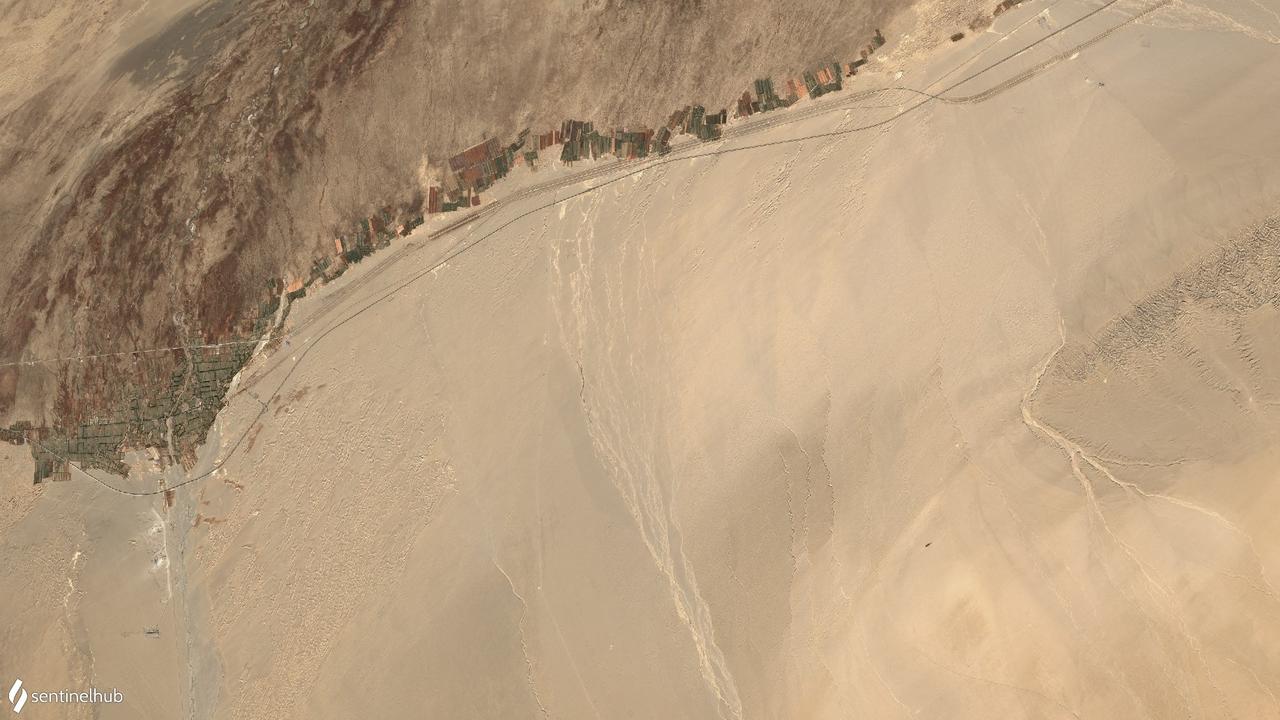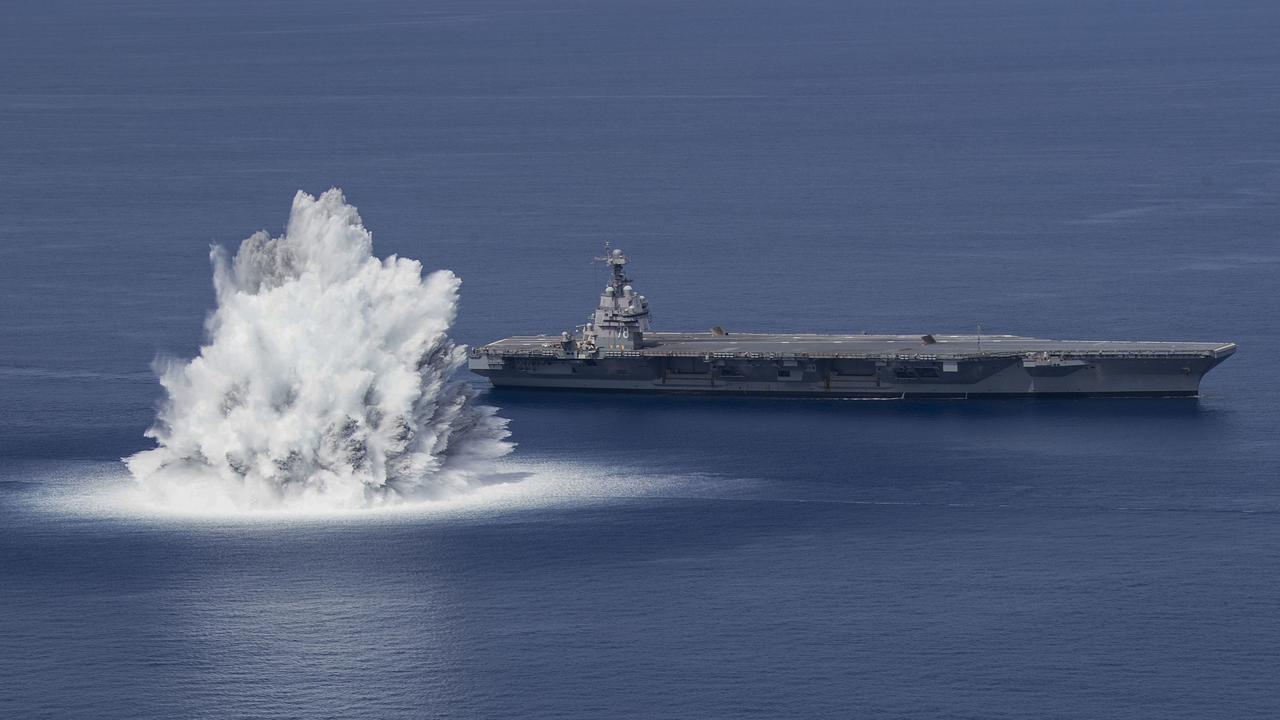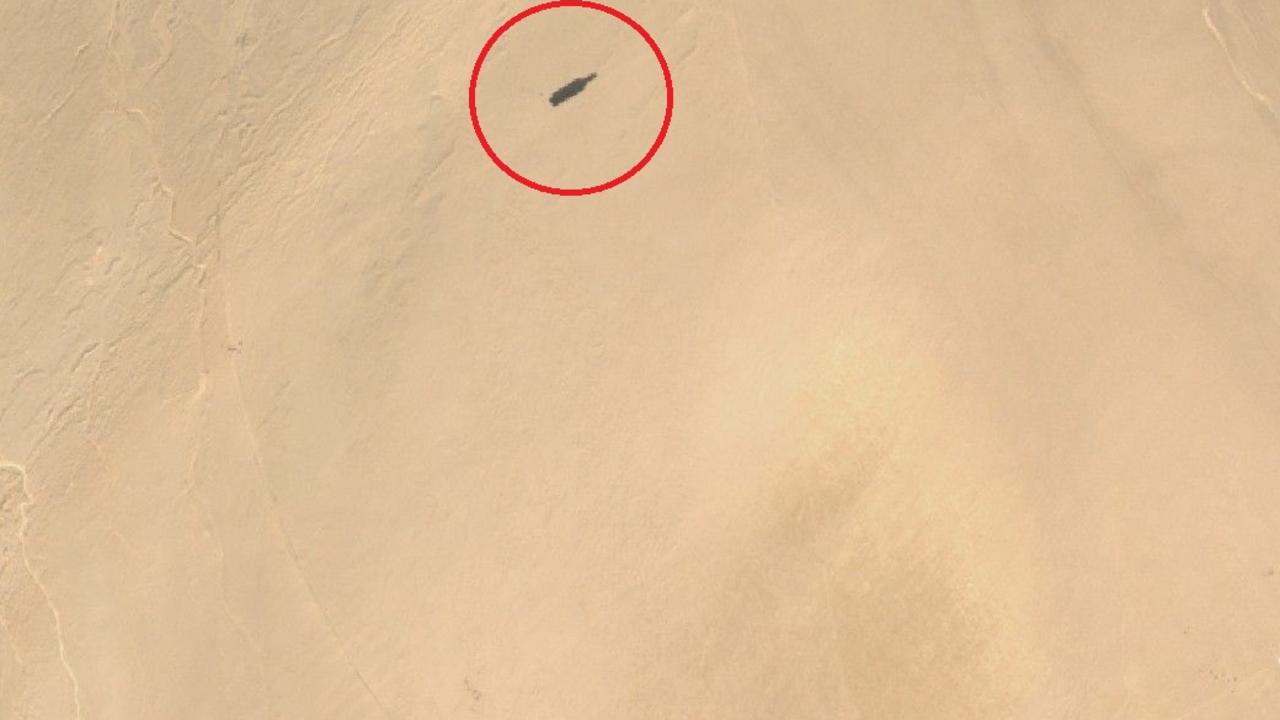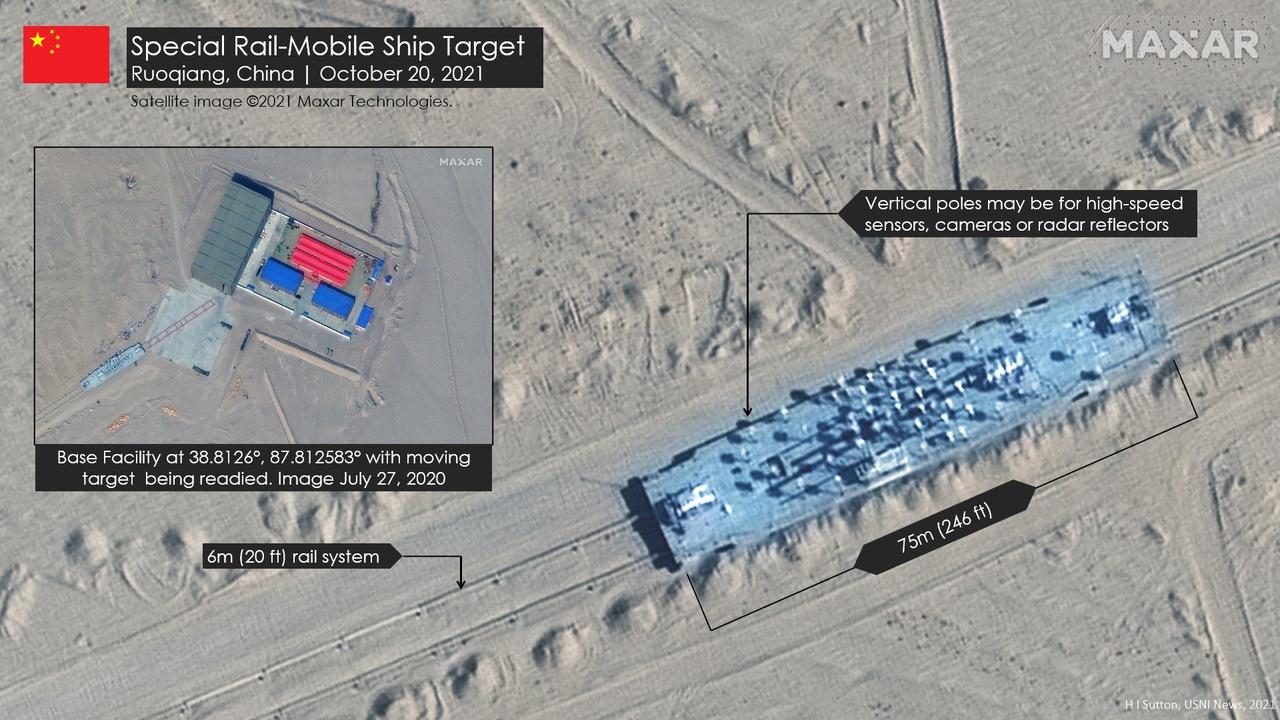Satellite images expose China practising blowing up US warships
Satellite photos have exposed China’s determination to have superiority over the US military, with an alarming “mock-up” caught on camera.
Innovation
Don't miss out on the headlines from Innovation. Followed categories will be added to My News.
Satellite photos have revealed China’s is so concerned with being able to destroy the United States’ enormous 100,000-ton aircraft carriers that it has built a mobile mock-up target in the middle of a desert.
The US Naval Institute has published images based on a report from AllSource Analysis identifying a new use for an old ballistic missile live-fire testing range in the Taklamakan Desert, near the town of Ruoqiang in Xinjiang.
It’s been rebuilt to practice sinking US warships.

Commercial satellite photos from Maxar and Copernicus Sentinel Hub have captured the outlines of the United States’ most modern warships in a salt pan southwest of the remote town. The complex constructions emulate the USS Gerald R. Ford aircraft carrier and two USS Arleigh Burke-class destroyers.
A railway track, which outlines the evasive manoeuvres of a warship, weaves among them. On it sits a 75 metre-long wheeled platform festooned with poles that simulate the radar reflections of different vessels.
Simulated strike
AllSource Analysis believes the mock-ups “could simulate targets related to seeking/target acquisition testing”.
BREAKING: #China has built a #USNavy aircraft carrier in the remote desert. This is new, much more sophisticated range than the classic from years ago. Destroyers and targets on rails too. Loads of images from @capellaspace and @Maxarhttps://t.co/4oh6EDiV22
— H I Sutton (@CovertShores) November 7, 2021
That could explain the lack of apparent weapons impact craters in the area of the mock-ups. And why the warship shapes have a distinctive appearance under space-based radar imaging.
Specifically, the attention to detail and sensor arrays indicate the range is intended to test the ability of hypersonic warheads to identify their intended target and track its movement.
China and Russia are leading the world in the development of this challenging new weapons technology.
Russia already has an air-launched “Kinzhal” hypersonic missile in service. The new ship-launched “Zircon” is capable of moving at speeds of between six and eight times the speed of sound. It’s said to be due for operational deployment next year.
The People’s Liberation Army’s DF-21D missile has a range of about 1700km. Its warhead is an “extremely” manoeuverable glide vehicle that can home-in on targeted ships.

The newer DF-26 can deliver a similar warhead out to some 5000km distance.
Then, in July and August, China sent shockwaves around the world when it tested a new kind of hypersonic weapon capable of orbiting the Earth.
Great video of 40,000 pound explosive going off for USS Ford @Warship_78 shock test trials! 🇺🇸⚓ï¸
— Seb H (@sebh1981) June 20, 2021
pic.twitter.com/apRe608JgY
Altogether, such technological advances have been a point of growing concern for Western navies in recent years. Particularly for the United States and its enormous 333 metre-long, nuclear-powered aircraft carriers.
Making carriers obsolete
The power of aircraft carriers was demonstrated in World War II when their ability to deploy speedily and stealthily left no coastal region safe from their swarms of combat aircraft.
This combination of speed, stealth and long reach dethroned the previous king of the oceans – the battleship.
Now China and Russia are banking on modern surveillance systems combined with the extreme range and speeds of hypersonic glide vehicles to do the same to carriers.
In recent decades, the primary threat to warships has been supersonic cruise missiles. These weapons could be launched from land, air, sea or submarine and travel hundreds of kilometres to their targets.
This is the threat the Aegis radar and missile systems fitted to the USS Burke-class destroyers (and Australia’s Hobart-class air warfare frigates) are designed to defeat.
The new ballistic-missile launched hypersonic glide warheads can fly at well over 6000km/h. Ranges vary but tend to be much greater than older cruise missiles. And they can dodge defensive radar and interceptors.
Attempts to update US Aegis systems to contend with this threat has so far met limited success.


The equation is disturbingly simple.
The new USS Gerald R. Ford aircraft carrier costs $A18 billion. Once its protracted development problems are eventually overcome, it will be capable of carrying some 80 or so F-35C Lightning II stealth fighters and helicopters.
The problem is, the decade-late F-35C (worth about $A100 million each) has a combat radius of just 1250km.
That means China’s hypersonic glide weapons (each costing somewhere in the range of $A30 million) can hit the USS Ford long before its aircraft can hit back.
The greatest challenge so far has been the prospect of hitting a ship moving and manoeuvring at 30 knots after travelling thousands of kilometres at more than five times the speed of sound.
That’s what the new Xinjiang testing range appears to be all about.
Pentagon alarmed
“We’re witnessing one of the largest shifts in global geostrategic power that the world has witnessed”, Chairman of the US Joint Chiefs of Staff General Mark Milley told the Aspen Security Forum in Washington last week.
He was specifically referring to Beijing’s advances in hypersonic missiles and rapidly expanding nuclear arsenal. He compared the impact of the new technologies to that experienced in World War II.
“If we, the United States military, don’t do a fundamental change to ourselves in the coming 10 to 15 to 20 years, then we’re going to be on the wrong side of a conflict,” he said.
That’s precisely where Beijing wants them to be.
“We are doing this because of their provocation,” Beihang University Professor Wang Xiangsui reportedly said of the August test.
In June, Director of the US Missile Defence Agency Vice Admiral Jon Hill told the US Senate that US aircraft carriers are already facing an unprecedented threat.
He was urging renewed focus and investment in new defensive technologies.
“It’s important that we have that capability now because the hypersonic threat is there now,” he said. “Regional hypersonic defence will first focus on defence in the terminal phase,” he added, referring to the moment the warhead approaches its target.
But that will rely heavily upon early warning from space-based sensors aboard new satellites and new high-speed, high-accuracy interceptor missiles.
Currently, the US navy is pinning its hopes on the SM-6 interceptor missile paired to upgraded Aegis radar and guidance systems. “That is the first regional hypersonic missile defence capability that is deployed with the aircraft carrier strike groups today,” added Admiral Hill.
More Coverage
Originally published as Satellite images expose China practising blowing up US warships









